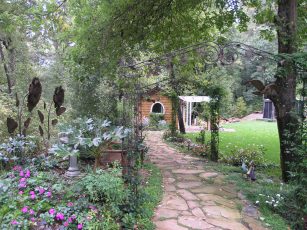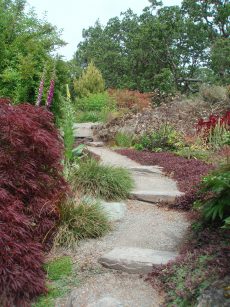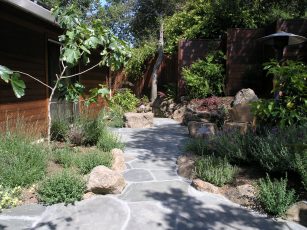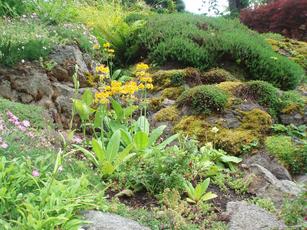You can be led down the garden path or get off the beaten path or take the path less traveled. Everywhere are references to paths in literature and philosophy. Paths make a garden more interesting, too. Simply by changing the shape of your path or the materials underfoot or adding a focal point at a bend, yours can change the look of your whole garden. Consider some of these ideas to update your path.

Every garden path begs you to wonder where does it lead? It’s the journey as well as the destination that makes it so alluring. As you walk, the garden should slowly reveal surprises. An architectural accent plant might appear, a wonderful scent greet you, a distant view open up or a drift of colorful flowers at the edge may beckon you to stop and enjoy the scene.
In the front yard you want a solid path directing visitors from the parking area to the front door. It should be wide enough to accommodate two people walking side by side with interesting views along the way like low walls or plant materials to create a sense of enclosure. You want a person to feel they are walking through a defined space and although you may alter the direction of the entry walk to make it more interesting the purpose of the path is to find the front entry area.
But what about all those other paths that wind around the house and in the back garden? Here’s where you can get creative.
Paths can be designed to slow people down. Plan pauses along the

way, widening it at some spots while placing a sitting bench nestled beside a bird feeder at another spot. Place a unique piece of garden art next to a tree with interesting bark or a view of distant mountains. You can route paths in ways that direct your sight toward beautiful things and away from the compost pile and trash cans. Good paths have entries that are easy to see and pull you in.
When I design a path in a garden I think about how it will fit into the rest of the landscape and the look of the house. Flagstone, brick or pavers are great for paths you’re likely to travel on barefoot. You can soften the path’s look by planting low ground covers between pavers. Allow at least 2 inches of soil between flagstone or pavers and amend the soil so it won’t pack down with foot traffic before planting.
Bark or gravel looks great for natural looking paths and a gently curving path invites you to stroll among the plants. If it leads you to a small circular patio all the better.

How wide should you make an informal path? If you want to soften the edge with low plants, allow 3 1/2 to 4 feet. Small grasses, aromatic herbs, fragrant flowers and colorful foliage plants look natural beside a path.
An interesting path I encountered once was created from materials found onsite. Old untreated redwood timbers were cut and installed at an angle every 6 feet or so along a packed decomposed granite path. In between were small pieces of flagstone connected with bands of 2 inch black Mexican pebbles. The look was interesting and inexpensive to achieve.
Look around your own yard for found items that would give your path that personal touch. Old bricks and broken concrete will find new life and you’ll save the expense of having to haul it away.


